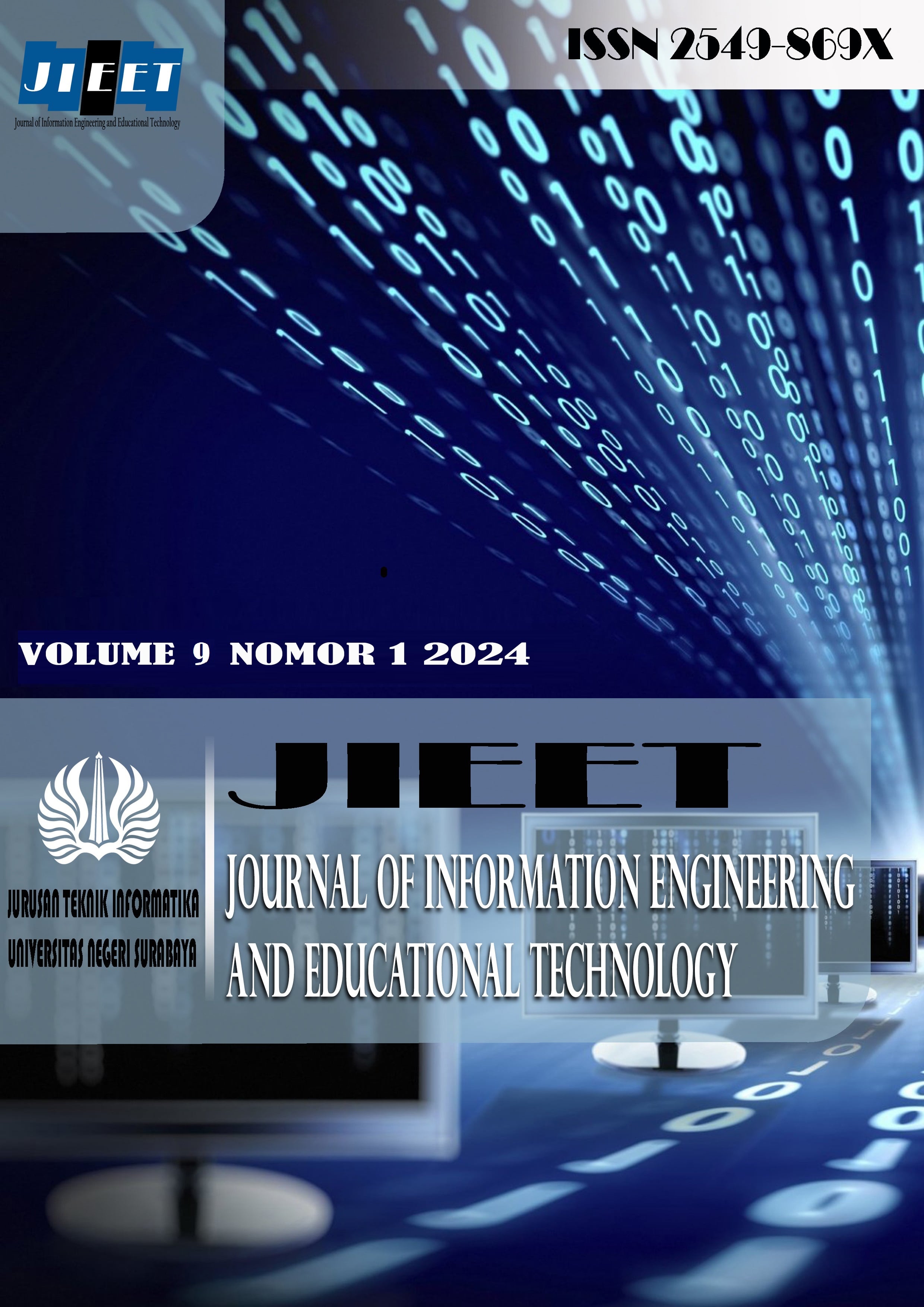Explainable Artificial Intelligence (XAI) for Identification of Using Obesity Factors Hybrid Artificial Neural Network Approach and SHapley Additive exPlanations
Main Article Content
Abstract
This study aims to develop and evaluate an obesity classification model using an Artificial Neural Network (ANN) combined with Explainable Artificial Intelligence (XAI) techniques based on SHAP (SHapley Additive exPlanations). The model was trained and tested using two different optimizers, Adaptive Moment Estimation (Adam) and Stochastic Gradient Descent (SGD), across multiple train-test ratios and epoch variations. The experimental results indicate that the Adam optimizer consistently outperformed SGD in terms of accuracy, loss value, and stability of evaluation metrics. The best performance was achieved with a 90:10 train-test ratio at 100 epochs, yielding an accuracy of 94.74%, a loss of 0.1899, precision, recall, and an f1-score of 0.95. To improve interpretability, SHAP was applied to identify the most influential features in the classification process. The analysis revealed that features such as Weight, Height, Gender, and Age significantly contribute to the model's predictions. Based on the SHAP interpretation, feature selection was conducted using the top nine features with the highest SHAP values. Retraining the ANN with these selected features resulted in improved performance, achieving 98.56% accuracy, a loss of 0.0638, and a precision, recall, and F1-score of 0.99 . These findings demonstrate that integrating XAI with ANN not only enhances transparency and interpretability but also boosts classification performance and computational efficiency. This approach shows strong potential for supporting decision-making in healthcare, particularly for early detection and intervention in cases related to obesity.
Article Details

This work is licensed under a Creative Commons Attribution-NonCommercial-ShareAlike 4.0 International License.
References
[1] T. Khater, H. Tawfik, and B. Singh, “Explainable artificial intelligence for investigating the effect of lifestyle factors on obesity,” Intelligent Systems with Applications, vol. 23, Sep. 2024, doi: 10.1016/j.iswa.2024.200427.
[2] W. Lin, S. Shi, H. Huang, J. Wen, and G. Chen, “Predicting risk of obesity in overweight adults using interpretable machine learning algorithms,” Front Endocrinol (Lausanne), vol. 14, 2023, doi: 10.3389/fendo.2023.1292167.
[3] Z. Helforoush and H. Sayyad, “Prediction and classification of obesity risk based on a hybrid metaheuristic machine learning approach,” Front Big Data, vol. 7, 2024, doi: 10.3389/fdata.2024.1469981.
[4] J. H. Bae, J. W. Seo, X. Li, S. Y. Ahn, Y. Sung, and D. Y. Kim, “Neural network model for prediction of possible sarcopenic obesity using Korean national fitness award data (2010–2023),” Sci Rep, vol. 14, no. 1, Dec. 2024, doi: 10.1038/s41598-024-64742-w.
[5] C. Ogami et al., “An artificial neural network−pharmacokinetic model and its interpretation using Shapley additive explanations,” CPT Pharmacometrics Syst Pharmacol, vol. 10, no. 7, pp. 760–768, Jul. 2021, doi: 10.1002/psp4.12643.
[6] S. S. Singh Rana, J. S. Ghahremani, J. J. Woo, R. A. Navarro, and P. N. Ramkumar, “A Glossary of Terms in Artificial Intelligence for Healthcare,” Arthroscopy - Journal of Arthroscopic and Related Surgery, Feb. 2024, doi: 10.1016/j.arthro.2024.08.010.
[7] S. Azmi et al., “Harnessing Artificial Intelligence in Obesity Research and Management: A Comprehensive Review,” Diagnostics, vol. 15, no. 3, Feb. 2025, doi: 10.3390/diagnostics15030396.
[8] A. K. Tripathi, N. R. Chauhan, and A. Sharma, “Obesity Classification and Prognosis Using Machine Learning,” AIP Conf Proc, vol. 3224, no. 1, Feb. 2025, doi: 10.1063/5.0245938.
[9] N. K. A. P. S. Dewi, A. W. Wijayanto, and J. A. Nursiyono, “Comparison of Machine Learning Algorithms in Classifying Districts/Cities in Indonesia According to the Human Development Index (HDI) in 2021,” Jurnal Sains, Nalar, dan Aplikasi Teknologi Informasi, vol. 4, no. 1, pp. 26–33, Jan. 2025, doi: 10.20885/snati.v4.i1.4.
[10] F. Arifin, H. Sibyan, and N. Hasanah, “Rancang Bangun Chatbot Pada Sistem EKAPTA Berbasis Natural Language Processing dengan Algoritma Artificial Neural Network,” Jurnal Ilmiah Informatia dan Komputer, vol. 4, no. 1, pp. 1–8, Jan. 2025, doi: 10.32699/biner.v4i1.7687.
[11] C. Özkurt, “Examination and Evaluation of Obesity RiskFactors with Explainable Artificial Intelligence,” Computers and Electronics in Medicine, Jul. 2024, doi: 10.69882/adba.cem.2024072.
[12] Q. Sun, A. Akman, and B. W. Schuller, “Explainable Artificial Intelligence for Medical Applications: A Review,” ACM Trans Comput Healthc, no. 2, Feb. 2025, doi: 10.1145/3709367.
[13] F. M. Palechor and A. de la H. Manotas, “Dataset for estimation of obesity levels based on eating habits and physical condition in individuals from Colombia, Peru and Mexico,” Data Brief, vol. 25, Aug. 2019, doi: 10.1016/j.dib.2019.104344.
[14] S. Mondal, R. Maity, and A. Nag, “An efficient artificial neural network-based optimization techniques for the early prediction of coronary heart disease: comprehensive analysis,” Sci Rep, vol. 15, no. 1, Dec. 2025, doi: 10.1038/s41598-025-85765-x.
[15] A. S. Ritonga and I. Muhandhis, “Teknik Data Mining Untuk Mengklasifikasikan Data Ulasan Destinasi Wisata Menggunakan Reduksi Data Principal Component Analysis (PCA),” Jurnal Ilmiah Edutic, vol. 7, no. 2, 2021, doi: 10.21107/edutic.v7i2.9247.
[16] S. Layeghay, M. Portmann, M. Gallagher, and L. Manocchio, “An Empirical Evaluation of Preprocessing methods for Machine Learning based Network Intrusion Detection Systems,” SSRN, Jan. 2025, [Online]. Available: https://ssrn.com/abstract=5079226
[17] H. Syahidah, N. Irsandi, A. N. Ajizah, and A. Amelia, “Obesity Prediction Using Machine Learning Algorithms,” IJATIS: Indonesian Journal of Applied Technology and Innovation Science, vol. 2, no. 1, pp. 53–62, Mar. 2025, doi: 10.57152/ijatis.v2i1.1869.
[18] A. Bhandari and G. Adhikari, “Artificial Neural Network for Digits Classification,” TechRxiv, Feb. 2025, doi: 10.36227/techrxiv.173895043.31733566/v1.
[19] M. Azad, M. F. K. Khan, and S. A. El-Ghany, “XAI-Enhanced Machine Learning for Obesity Risk Classification: A Stacking Approach with LIME Explanations,” IEEE Access, 2025, doi: 10.1109/ACCESS.2025.3530840.
